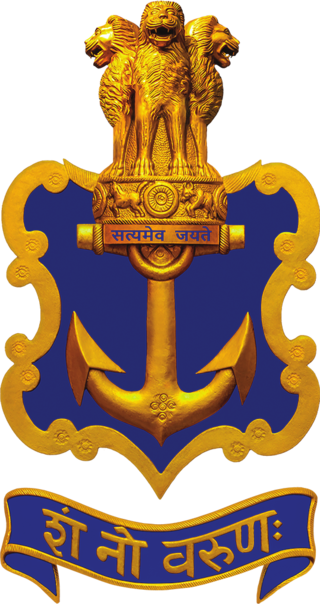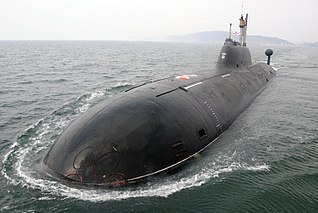
The Indian Navy is the maritime branch of the Indian Armed Forces. The President of India is the Supreme Commander of the Indian Navy. The Chief of Naval Staff, a four-star admiral, commands the navy. As a blue-water navy, it operates significantly in the Persian Gulf Region, the Horn of Africa, the Strait of Malacca, and routinely conducts anti-piracy operations and partners with other navies in the region. It also conducts routine two to three month-long deployments in the South and East China seas as well as in the western Mediterranean sea simultaneously.

INS Sindhurakshak was a Russian-made Kilo-class 877EKM (Sindhughosh-class) diesel-electric submarine of the Indian Navy. Commissioned on 24 December 1997, it was the ninth of the ten Kilo-class submarines in the Indian Navy. On 4 June 2010, the Indian Defence Ministry and Zvezdochka shipyard signed a contract worth US$80 million to upgrade and overhaul the submarine. After the overhaul, it returned to India from Russia between May and June 2013.

Sindhughosh-class submarines are Kilo-class diesel-electric submarines in active service with the Indian Navy. Their names are in Sanskrit, but in their Roman-alphabet forms sometimes a final short -a is dropped.

The Scorpène-class submarines are a class of diesel-electric attack submarines jointly developed by the French Naval Group and the Spanish company Navantia. It features diesel propulsion and an additional air-independent propulsion (AIP). It is now marketed as the Scorpène 2000.
The Arihant-class is a class of Indian nuclear ballistic missile submarines under construction for the Indian Navy. They were developed under the ₹900 billion (US$11 billion) Advanced Technology Vessel (ATV) project to design and build nuclear-powered submarines. These vessels are classified as 'strategic strike nuclear submarines' by India.
The Indian Naval Air Arm is the aviation branch and a fighting arm of the Indian Navy which is tasked to provide an aircraft carrier-based strike capability, fleet air defence, maritime reconnaissance, and anti-submarine warfare.

Nerpa is a 8,140-tonne (8,010-long-ton) Project 971 nuclear-powered attack submarine. The construction of the submarine was started in Russia in 1993, but was suspended due to lack of funding. India then sponsored further construction and sea trials of the submarine provided it was leased to the Indian Navy for 10 years. It was launched as K-152 Nerpa in October 2008 and entered service with the Russian Navy in late 2009. The submarine was leased to the Indian Navy in 2011 after extensive trials, and was formally commissioned into service as INS Chakra with the Eastern Naval Command at a ceremony in Visakhapatnam on 4 April 2012. In June 2021 Chakra was spotted on the surface escorted by Indian and Russian warships in the Singapore Strait while presumably heading towards the Russian naval base in Vladivostok; some media speculated that she was returning to Russia before the expiry of the lease term.

INS Arihant, designated S2 Strategic Strike Nuclear Submarine, is the lead ship of India's Arihant class of nuclear-powered ballistic missile submarines. The 6,000 tonne vessel was built under the Advanced Technology Vessel (ATV) project at the Ship Building Centre in the port city of Visakhapatnam.

INS Sindhukirti (S61) is the seventhSindhughosh-class diesel-electric submarine of the Indian Navy. She was built at the Admiralty Shipyard and Sevmash in the Soviet Union.

The Kalvari-class submarines, formally classified as the Project-75 submarines (P-75), is a class of diesel-electric attack submarines operated by the Indian Navy. Currently being constructed by a syndicate of French and Indian shipyards, namely, Naval Group and Mazagon Dock Limited (MDL) respectively, the class is an export derivative of the French-origin Scorpène-class submarine, originally designed by Naval Group.

Vela-class submarines of the Indian Navy were variants of the later Soviet Foxtrot-class submarines. The last of the class was decommissioned from the Indian Navy in December 2010. The submarines formed the 8th Submarine Squadron and were based at INS Virbahu.
INS Vela (S40) was the lead ship of four diesel-electric Vela-class submarines of the Indian Navy. The submarine was commissioned on 31 August 1973 in Riga, Latvian SSR. Along with her sister ship Vagli, she spent almost 10 years undergoing a protracted refit by Hindustan Shipyard. After 37 years of service, the submarine was decommissioned on 25 June 2010. The submarine was claimed by the Eastern Naval Command to be the oldest operational submarine in the world at the time of her decommissioning.
INS Vagir (S41) was a Vela-class diesel-electric submarine of the Indian Navy.

Hindustan Shipyard Limited (HSL) is a shipyard located in Visakhapatnam on the east coast of India.

INS Vajrabahu is an Indian Navy submarine base of the Western Naval Command located near Mumbai in Maharashtra. It was commissioned on 1 February 1996.

The Indian Navy has been focusing on developing indigenous platforms, systems, sensors and weapons as part of the nation's modernisation and expansion of its maritime forces. As of November 2023, the Indian Navy had 67 vessels of various types under construction including destroyers, frigates, corvettes, conventional-powered and nuclear-powered submarines and various other ships. It plans to build up to a total of 200 vessels and 500 aircraft by 2050. According to the Chief of the Naval Staff's statement in December 2020, India has transformed from a buyer's navy to a builder's navy.

INS Vela (S24) is the fourth submarine of the first batch of six Kalvari-class submarines for the Indian Navy. It is a diesel-electric attack submarine based on the Scorpène class, designed by French naval defence and energy group DCNS and manufactured by Mazagon Dock Limited, an Indian shipyard in Mumbai. The first cutting of steel for the submarine began on 14 July 2009, and the ship was launched on 6 May 2019.

The Commodore Commanding Submarines (East) is an operational appointment in the Indian Navy. The COMCOS (E) is the commander of the all submarines and allied units of Eastern Naval Command. Based in Visakhapatnam, Andhra Pradesh, the COMCOS is also the Commanding Officer of the submarine base INS Virbahu. Currently, there are two COMCOS in the Indian Navy, COMCOS (East) and COMCOS (West). The COMCOS (E) is a one star officer holding the rank of Commodore. The current COMCOS (E) is Commodore K. Venkatraman, VSM who took over on 20 February 2020.

The Commodore Commanding Submarines (West) is an operational appointment in the Indian Navy. The COMCOS (W) is the commander of the all submarines and allied units of Western Naval Command. Based in Mumbai, Maharashtra, the COMCOS is also the Commanding Officer of the submarine base INS Vajrabahu. Currently, there are two COMCOS in the Indian Navy, COMCOS (East) and COMCOS (West). The COMCOS (W) is a one star officer holding the rank of Commodore. The current COMCOS (W) is Commodore Anurag Srivastava.












